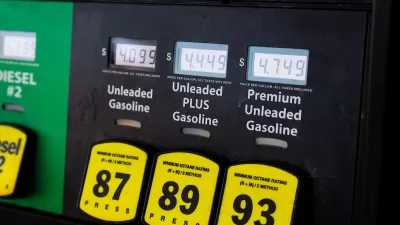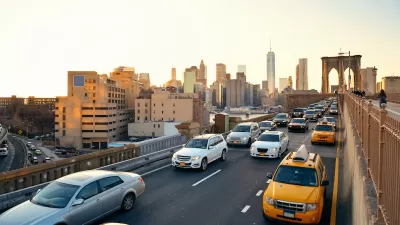It's 1973 again in 12 counties - this time Hurricane Sandy, rather than OPEC, is to blame. For those carrying gas cans rather than driving (or pushing) cars to the stations, they're exempt. The military and FEMA will deliver more fuel to NY and NJ.
For those old enough to remember, President Nixon instituted price controls and rationing as a result of long gas lines stemming from the Arab oil embargo. Gov. Chris Christi, citing "the long lines and otherwise disorderly sales of fuel following Hurricane Sandy", took similar action on Nov. 02 by signing "an executive order [PDF]...announcing a state of energy emergency and instituting gas rationing for the purchase of fuel by motorists in 12 counties, starting Saturday, Nov. 03 at noon."
Gov. Christie called "the fuel supply in the state a 'shortage' that could endanger public health, safety and welfare, the rationing will take place in Bergen, Essex, Hudson, Hunterdon, Middlesex, Morris, Monmouth, Passaic, Somerset, Sussex, Union and Warren counties."
"According to the order, all retail gasoline dealers are required to sell fuel for use in a passenger vehicle according to the last number appearing on a vehicle's license plate.
- Vehicles with license plates, the last number of which is an odd number, can fill up at stations in these counties only on odd-numbered days of the month, the order said.
- Vehicles with license plates, the last number of which is an even number, can fill up only on even-numbered days." (Zero is treated as even number)
Winnie Hu writes in the The New York Times that New York Harbor, which had been closed due to Hurricane Sandy, "was partly reopened to ships on Thursday (Nov. 01). To help move gasoline faster to customers, (NY Gov. Andrew) Cuomo said he was waiving a requirement that fuel tankers docking in New York register and pay a tax before unloading."
President Obama also addressed the fuel shortage. Writing in the The New York Times, Eric Lipton and Clifford Krauss report that in response to "panic buying by the public...the Defense Department (will) send 24 million gallons of fuel to the region".
The military will go beyond supplying gas stations with fuel. The northeast remains dependent on heating oil as well.
"The Pentagon has also been authorized by the Energy Department and the White House to tap the Northeast Home Heating Oil Reserve. It will draw as much as two million gallons of diesel fuel - part of the 12 million total - for government emergency responders, helping them to keep electricity generators, water pumps, federal buildings, trucks and other vehicles running. The oil reserve, created by the federal government in 2000, holds 42 million gallons of ultralow-sulfur diesel at terminals in Groton, Conn., and Revere, Mass. It is the first time fuel has been released from the reserve."
The West Coast would have benefited from such a reserve in its recent shortage of gasoline resulting from refinery and distribution break-downs. While some gas stations voluntarily closed down, most stations adjusted their prices accordingly, resulting in a 50 cent price increase the first week of October.
Raising prices in times of shortage was explored by NPR on Nov. 02 in "Some Economists Think Price Gouging Is Good". In fact, some "experts contend it was price controls, not a spike in oil and gas prices, that prompted rationing and gasoline shortages" in the 1970s writes CNN/Money's Chris Isidore on October 13, 2004.
Thanks to Peter Flieg
FULL STORY: Gov. Christie signs order to ration gas in 12 N.J. counties

Study: Maui’s Plan to Convert Vacation Rentals to Long-Term Housing Could Cause Nearly $1 Billion Economic Loss
The plan would reduce visitor accommodation by 25,% resulting in 1,900 jobs lost.

North Texas Transit Leaders Tout Benefits of TOD for Growing Region
At a summit focused on transit-oriented development, policymakers discussed how North Texas’ expanded light rail system can serve as a tool for economic growth.

Why Should We Subsidize Public Transportation?
Many public transit agencies face financial stress due to rising costs, declining fare revenue, and declining subsidies. Transit advocates must provide a strong business case for increasing public transit funding.

How to Make US Trains Faster
Changes to boarding platforms and a switch to electric trains could improve U.S. passenger rail service without the added cost of high-speed rail.

Columbia’s Revitalized ‘Loop’ Is a Hub for Local Entrepreneurs
A focus on small businesses is helping a commercial corridor in Columbia, Missouri thrive.

Invasive Insect Threatens Minnesota’s Ash Forests
The Emerald Ash Borer is a rapidly spreading invasive pest threatening Minnesota’s ash trees, and homeowners are encouraged to plant diverse replacement species, avoid moving ash firewood, and monitor for signs of infestation.
Urban Design for Planners 1: Software Tools
This six-course series explores essential urban design concepts using open source software and equips planners with the tools they need to participate fully in the urban design process.
Planning for Universal Design
Learn the tools for implementing Universal Design in planning regulations.
City of Santa Clarita
Ascent Environmental
Institute for Housing and Urban Development Studies (IHS)
City of Grandview
Harvard GSD Executive Education
Toledo-Lucas County Plan Commissions
Salt Lake City
NYU Wagner Graduate School of Public Service




























